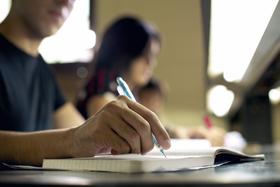Serving 393 students in grades 6-8, Casey Middle School ranks in the bottom 50% of all schools in Colorado for overall test scores (math proficiency is bottom 50%, and reading proficiency is bottom 50%).
The percentage of students achieving proficiency in math is 22% (which is lower than the Colorado state average of 33%). The percentage of students achieving proficiency in reading/language arts is 44% (which is lower than the Colorado state average of 45%).
The student-teacher ratio of 12:1 is lower than the Colorado state level of 15:1.
Minority enrollment is 60% of the student body (majority Hispanic), which is higher than the Colorado state average of 50% (majority Hispanic).
Quick Facts (2025-26)
- Grades: 6-8
- Enrollment: 393 students
- Student-Teacher Ratio: 12:1
- Minority Enrollment: 60%
- Overall Testing Rank: Bottom 50% in CO
- Math Proficiency: 22% (Btm 50%)
- Reading Proficiency: 44% (Top 50%)
- Science Proficiency: 25-29% (Top 50%)
- Source: National Center for Education Statistics (NCES), CO Dept. of Education
School Overview
Casey Middle School's student population of 393 students has declined by 41% over five school years.
The teacher population of 33 teachers has declined by 17% over five school years.
Grades Offered
Grades 6-8
(No virtual instruction)
(No virtual instruction)
Total Students
393 students
Gender %
Total Classroom Teachers
33 teachers
School Calendar
Last Day of School
Fri. Jun 19, 2026
School Rankings
Casey Middle School ranks within the bottom 50% of all 1,748 schools in Colorado (based off of combined math and reading proficiency testing data).
The diversity score of Casey Middle School is 0.59, which is less than the diversity score at state average of 0.62. The school's diversity has stayed relatively flat over five school years.
Overall Testing Rank
#969 out of 1748 schools
(Bottom 50%)
(Bottom 50%)
Math Test Scores (% Proficient)
22%
33%
Reading/Language Arts Test Scores (% Proficient)
44%
45%
Science Test Scores (% Proficient)
(20-21)25-29%
29%
Student-Teacher Ratio
12:1
15:1
American Indian
n/a
1%
Asian
4%
3%
Hispanic
50%
36%
Black
1%
5%
White
40%
50%
Hawaiian
n/a
n/a
Two or more races
5%
5%
All Ethnic Groups
Eligible for Free Lunch
54%
39%
Eligible for Reduced Lunch
3%
6%
School Statewide Testing
School District Name
Source: National Center for Education Statistics (NCES), CO Dept. of Education
Profile last updated: 02/09/2025
Frequently Asked Questions
What is Casey Middle School's ranking?
Casey Middle School is ranked #969 out of 1,748 schools, which ranks it among the bottom 50% of public schools in Colorado.
What schools are Casey Middle School often compared to?
Casey Middle Schoolis often viewed alongside schools like Southern Hills Middle School, Centennial Middle School by visitors of our site.
What percent of students have achieved state testing proficiency in math and reading?
22% of students have achieved math proficiency (compared to the 33% CO state average), while 44% of students have achieved reading proficiency (compared to the 45% CO state average).
How many students attend Casey Middle School?
393 students attend Casey Middle School.
What is the racial composition of the student body?
50% of Casey Middle School students are Hispanic, 40% of students are White, 5% of students are Two or more races, 4% of students are Asian, and 1% of students are Black.
What is the student-teacher ratio of Casey Middle School?
Casey Middle School has a student ration of 12:1, which is lower than the Colorado state average of 15:1.
What grades does Casey Middle School offer ?
Casey Middle School offers enrollment in grades 6-8 (No virtual instruction).
What school district is Casey Middle School part of?
Casey Middle School is part of Boulder Valley School District No. Re2.
In what neighborhood is Casey Middle School located?
Casey Middle School is located in the Whittier neighborhood of Boulder, CO. There are 1 other public schools located in Whittier.
School Reviews
2 10/10/2025
Casey is a good school in many ways, but there is a serious imbalance with respect to pressures placed on students in the bilingual track. The bilingual program is unnecessarily intense and there appears to be little interest in parent feedback. What could be a rich opportunity for a diverse group of children to learn Spanish AND core academics is instead a narrowly focused program tailored only to children who can cope with intense pressure, hours of daily homework, and an uncreative, NON-experiential approach to second-language learning. Teachers of core academics (lang. arts, science, math and social studies) repeatedly tell parents that they cannot give homework because of the extreme load placed on students by the bilingual teachers. Those teachers recognize the imbalance in the school! Parents repeatedly ask the bilingual teaches and leadership to reduce homework expectations. While school leadership claims to welcome parent input, in reality they are dismissive of parents' pleas for the bilingual program be placed in a more proper balance with other academics and appear undisturbed by the negative effect this has on students' interest in second language learning.
Review Casey Middle School. Reviews should be a few sentences in length. Please include any comments on:
- Quality of academic programs, teachers, and facilities
- Availability of music, art, sports and other extracurricular activities
Recent Articles

Public School Open House & Enrollment Season Guide
A parent-focused guide to the public school open house and enrollment season, with expert questions, timelines, and decision tips.

School Supply Budget 2026: Fees, Books, Tech Costs
School Supply Budget 2026 guide for parents, covering fees, textbooks, technology, and hidden extras to plan ahead.

Education Funding in America (2025 Update)
Comprehensive 2025 update on public school funding in America, new federal and state policies, per-pupil spending, and equity challenges.





